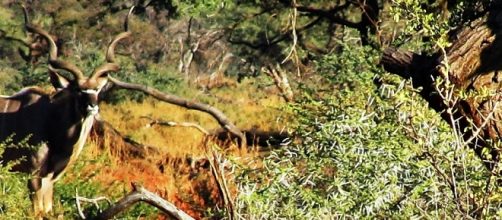Africa has some amazing trees. The giant bulbous baobab lives for thousands of years and the strangler fig kills its own host.
The Acacia tree, so often featured in stunning photographs of African sunsets, is one of the strangest of all. The acacia trees which form a large part of the diet of herbivores are capable of killing off the antelope that eat them. Going a step further, the trees can warn others of its kind that there are browsers in the area who would like to make a meal of them.
Perhaps the stately giraffe has known of the potentially lethal side effects of browsing on acacia for millennia.
Giraffe will stand in a forest of acacia and nibble gently and carefully at the uppermost young leaves and then move away upwind to another tree after a relatively short time, even though there are still lots of leaves left that it could eat.
The secret lethal reason for this is that Acacia trees are able to raise the tannin-C levels in their leaves when browsers start to eat them. Within fifteen minutes of an animal starting to eat, the tannin-C levels can shoot up to a higher than normal level. While tannin-C on its own is not a poison, it can combine with protein molecules from food in the gut of an antelope and make the leaves indigestible.
If the animals are confined in a fenced area and are unable to move away to browse in another area, they will literally starve to death on a savannah plain that looks like a benign woodland of plenty.
In human terms it would equate to being able to munch on as many of your favourite take-outs as you like and lose weight. The downside would be the dying of starvation bit at the end of it all.
Professor Wouter Van Der Hoven carried out a number of studies in 1990 after the inexplicable deaths of antelope known as the Kudu in South Africa. Eliminating other sources of the killer elements, he discovered the amazing fact that these acacia trees were capable of defending themselves from over-browsing by literally killing off the animals that ate their leaves.
To top this off, he found that they also release ethylene from damaged leaves which float downwind, and are absorbed by neighbouring trees.
The ethylene acts as a warning signal – a kind of chemical SOS. The neighbouring trees then start to produce more tannin-C before they are browsed.
In normal years when there is plenty of foliage, and the animals are not overstocked, there are enough trees for all to have a feed and move on to another area to browse. In the case of commercial game farms which have fenced paddocks, it is more difficult for the animals to find enough leaves to eat that contain safe tannin-C levels.
During drought when pressure on the trees is high, or where an imbalance between predator and prey species occurs in the wild, the antelope populations may become just too much for the carrying capacity of the land.
It is at this crucial point that acacias that are stressed from over-browsing will impact on antelope populations and literally kill them off.
Our living planet is an amazing, incredible place and we still have so much to learn about our natural heritage. The true story of the Acacia that kills in order to survive illustrates how vital it is for us to conserve entire eco-systems, if for no other reason than the fact that we simply do not know what we may be destroying if we don’t.
Wetnose Day 2015: fund-raising to provide care for sick or vulnerable animals

